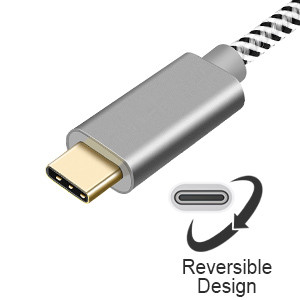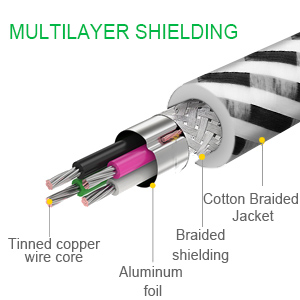In theory, all USB-C cables should be the same: that’s the whole point of having a standard. In practice, there are different versions of the standard. More worryingly, many cables being sold as USB-C don’t fully conform to that standard – and that can be seriously bad news …
USB-C is brilliant. You can fast charge your smartphone, tablet, and laptop, or, transfer data at high speed, all using the same USB-C to USB-C cable. Only that you have the right one. In contradiction to the unified USB-C standard, the situation of its cables is extremely confusing for average consumers, prosumers even.
The main reason behind this complex is that although USB-C opens tremendous possibilities, if a manufacturer decides to packs all those specs and features inside a cable, the cost would be too high for average consumers. That’s why we have so many USB-C to USB-C cables with different specs covering all price points.
So we have to know what we want, in two aspects: charging and data transfer.
1. Charger
A charger powers your device as fast as your cable allows. All USB-C cables must be able to carry a minimum of 3A current (at 20V, 60W). But for high-power 20V/5A (100W) charging, you need a 5A-rated USB-C to USB-C cable that contains E-Marker chip to identify the cable and its current capabilities. Or a Thunderbolt 3 cable that supports 5A/20V (100W) charging. So definitely check the current rating (3A or 5A) of the cable when you want fast charging high-power devices like MacBook Pro.
2. Speed
Data transfer is when things get messy. There are FIVE different kinds of USB-C to USB-C cables with various speeds from low to high as follows:
USB 2.0 (480Mbps) USB-C to USB-C cables (the most common ones)
USB 3.2 Gen 1 (5Gbps) USB-C to USB-C cables (formerly USB 3.1 Gen 1, support 10Gbps with upcoming USB 3.2 Gen 2×2 devices)
USB 3.2 Gen 2 (10Gbps) USB-C to USB-C cables (formerly USB 3.1 Gen 2, support 20Gbps with upcoming USB 3.2 Gen 2×2 devices)
Thunderbolt 3 (20Gbps) USB-C to USB-C cables (passive cables longer than 0.5m/1.6ft)
Thunderbolt 3 (40Gbps) USB-C to USB-C cables (passive cables shorter than 0.5m/1.6ft, or active cables longer than 0.5m/1.6ft, active cables lack backward compatibility with USB 3.x)
For most cases, a USB 3.2 Gen 2 (10Gbps) USB-C to USB-C cable (formerly USB 3.1 Gen 2) offers decent data transfer speed without breaking the bank. However, if you want to hook your laptop with an external GPU, a Thunderbolt 3 (40Gbps) cable is the one to get.
Some non-compliant cables simply won’t offer the full data speeds they promise. Others can’t be used for data at all. And yet others can draw too much power, which can not only damage any device you’re charging it with, but could even damage the USB port in your MacBook.
That latter problem is specific to older MacBooks, with a USB-A port. Those were designed with a maximum current draw as part of the spec. USB-C devices can draw significantly more power, so if you use a USB-A port to charge a USB-C device, then a non-compliant cable can draw more power than the port is designed to handle. That can damage both the device you’re charging and your MacBook. A compliant cable has a resistor to limit the current draw.
But the data and speed problems apply equally to MacBooks with USB-C ports. So, how do you ensure you’re buying a cable which is safe, supports data, and offers the full transfer speeds on offer? There are three methods you can use.
The first, and simplest, approach is to stick to reputable brands you can trust to adhere to the standards. Apple is an obvious one, but buying a trustworthy brand doesn’t necessarily mean paying Apple prices for your cables. STC-Cable is the brand which adhere to the standards, and are significantly cheaper.
Second, look for the SuperSpeed+ (SS+) logo. However, not all cables use the full logo, and may not distinguish between the older SS and newer SS+ labels. Some also use SS and a 10 to indicate 10GBps, instead of SS+, like the one above.
For that reason, it’s best to use the third method: look for the USB generation label, and make sure it’s USB 3.1 Gen 2, which supports 10Gbps (in contrast with USB 3.1 which is limited to 5Gbps). Just to complicate matters, you may also see USB 3.0 and USB 3.1 (with no generation suffix): these are older labels for USB 3.1 Gen 1 and Gen 2. The safest bet is to specifically look for USB 3.1 Gen 2.
Unless you want a cable only for charging purposes, beware of cables labelled ‘charge cable’ as that’s an immediate giveaway that they don’t support data transfer. This includes the charge cables Apple supplies inside product boxes.
Send your message to us:
Post time: Feb-29-2020



